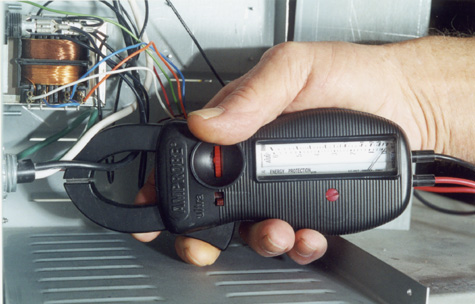 |
|
|
Kiln Pointers
|
|
|
Electrical Safety |
CONTENTS Electrical Safety Reader Response: Firing multiple shelves of glass in a kiln with only top elements Recent Q&As: Paper clay and the kiln’s warranty; firing a single-phase kiln in a three-phase building; mothballs in kilns Memorable Quote News: Basic In-Plant Kiln Maintenance Seminar ----------- ELECTRICAL SAFETY A friend told me that he used to work in a factory. One time he turned off the electrical breaker to repair a machine, not knowing that the machine was powered by two separate breakers. He touched a wire terminal with a screwdriver. Sparks shot out, tore a chunk out of the screwdriver tip, and destroyed the main breaker to the factory. Lights went out, and the humming of machines slowed and then stopped. People wondered what had happened. My friend was shaken but not hurt. You may never run across complicated wiring such as he encountered, but the lesson he learned may help you, too: Be prepared for the unexpected when working with electricity. 1) Before opening the control panel on your kiln, disconnect the power. Do not touch the heating elements with anything while the kiln is plugged in. 2) Find the circuit breaker for your kiln. Label the breaker. The inside of the circuit breaker box door usually has a list of labels. 3) Whenever you turn off the circuit breaker to your kiln, tape the breaker box door shut and leave a note saying, “WORKING ON KILN. BREAKER OFF.” 4) The side of a kiln becomes hot. Do not let the cord touch the kiln. Replace the cord if the insulation burns off. 5) During operation, place your hand on the kiln’s power cord to check the temperature. It is normal for the cord to be slightly warm, but it should never feel hot. 6) Make sure the plug is pushed all the way into the receptacle. 7) Keep a Class C fire extinguisher and a smoke alarm in the kiln room. Mount the extinguisher near the door to the room. ----------- READER RESPONSE Kilns with only top elements are not designed for multiple shelves of glass. Nevertheless, Judy Pagnusat of Cotati, California wrote, “I have stacked shelves in my Paragon Fusion-7 to create a tack fuse and a full fuse in the same load. We achieved exactly what we wanted on the first try. We actually stacked three shelves and got three different levels of fuse. We are ecstatic because often our students have had to wait until we had a full kiln of one type of fuse. This will cut the wait time. “Multiple-shelf firing in a glass kiln works with small pieces like jewelry, but not with larger slumpable items,” Judy added. Her experiments with larger pieces did not turn out. ----------- RECENT Q&As Q. Does firing paper clay affect the kiln’s warranty? A. Paper clay can create a reducing atmosphere in an electric kiln. However, as long as the kiln is well vented, the paper clay should not affect the Paragon warranty. Q. I have a 240-volt, single-phase kiln and am moving to a building that has 3-phase, 240 volts. Can I fire the kiln in that building? A. Yes, you can run your single-phase, 240-volt kiln on a 3-phase, 240-volt system. You do not need to rewire your kiln. There is a possibility, though, that a phase will be out of balance by running a single-phase kiln in the building. To be sure, talk to an electrician. Q. Is it safe to place a combustible material into a hot kiln through a peephole? This is to create a reduction atmosphere for crystalline glazes. A. We have always warned against inserting combustible materials into the kiln. It can be dangerous, especially with toxic materials such as mothballs. Reduction firing is also hard on the heating elements. The reduction atmosphere eats away the oxide coating on the element wire. ----------- MEMORABLE QUOTE “My Paragon SC-3 kiln . . . my precious! I talk to it, tell it we are ready to start the day, and it glows and makes that little turning on and off sound to keep me company.” –Ann Davis ----------- NEWS: PARAGON BASIC IN-PLANT SEMINAR OCTOBER 2 – 3, 2009 I hope you can attend the seminar, which will be held here at the factory. I look forward to meeting you. More details: http://www.paragonweb.com/News_Story.cfm?NID=93 ----------- Earlier this month I attended a copper enameling conference in Oakland, California. John Toki, co-author of “Hands in Clay” and owner of Leslie’s Ceramics, took me to the San Francisco streets where the chase scenes in the “Dirty Harry” movies were filmed. We drove down hills so steep that I felt like I was falling into space. You can read an interview with John Toki here: http://www.paragonweb.com/BookInfo.cfm?BID=56 Thank you, With best wishes, Arnold Howard Paragon Industries, L.P. – Better Designed Kilns 2011 South Town East Blvd., Mesquite, Texas 75149-1122 Voice: 972-288-7557 & 800-876-4328 / Fax: 972-222-0646 / ahoward@paragonweb.com / www.paragonweb.com PRIVACY NOTICE: Under no circumstance do we share or sell your email address. Copyright 2009, by Paragon Industries, L.P. |
|
|

|
|
|
|
|
“Custom and standard Kilns and Industrial Furnaces for ceramics, pottery, heat treating, enameling, |
||||
